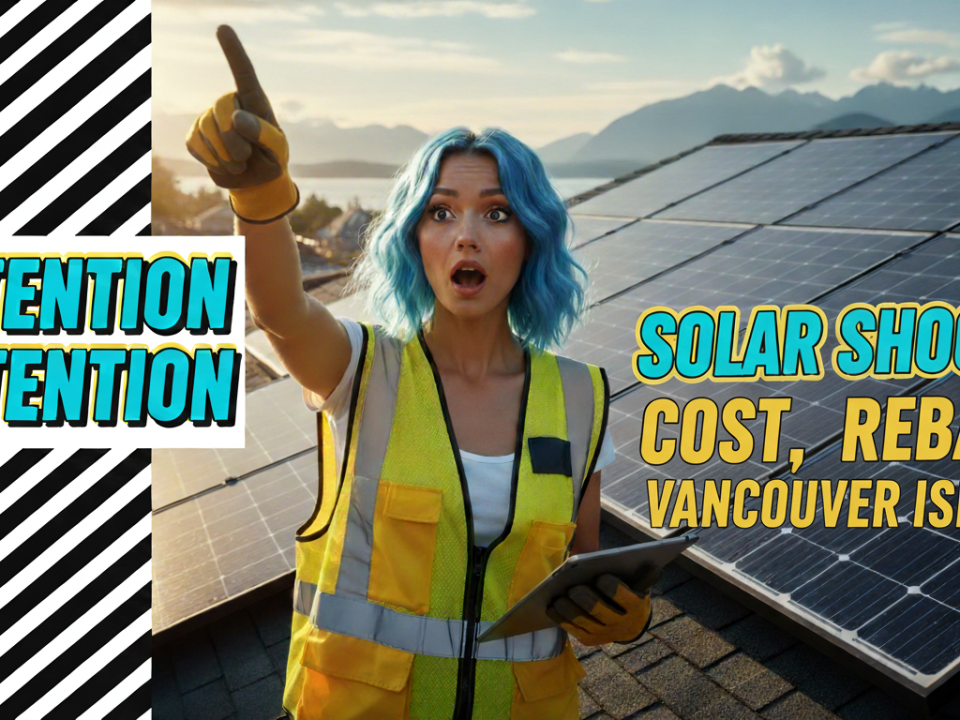
Solar Panels Prince Edward Island (PEI) Guide 2025
August 6, 2025
Solar Panels Yukon Guide 2025 + Calculator
August 7, 2025The Northwest Territories presents a unique case for solar energy. You’ve got some of the highest electricity rates in the country, but you also have some of the most challenging conditions. So, let’s get right into the data and see if installing solar panels in the NWT makes sense for you in 2025.
What is the Current State of Solar Energy Adoption?
Solar energy in the Northwest Territories is picking up steam, especially in communities that rely on diesel fuel for power. It’s not a massive boom like you might see in southern provinces, but it’s a steady, determined growth. The main driver is the sky-high cost of electricity. People are looking for ways to get control over their power bills.

The Government of the Northwest Territories (GNWT) is actively pushing for more renewable energy projects to reduce dependence on fossil fuels. This is laid out in their 2030 Energy Strategy. We’re seeing more solar installations on community buildings, businesses, and homes. Indigenous governments and organizations are leading some of the most significant projects, often with federal support, to build a cleaner energy future.
Why Consider Solar Energy in the Northwest Territories?
The number one reason is the cost of power. In communities that are not connected to the hydro grid, electricity rates can be incredibly high. We’re talking rates that can exceed $0.40 per kilowatt-hour (kWh) even after subsidies. When you’re paying that much, the idea of generating your own power becomes very attractive.
A solar installation allows you to lock in your electricity costs for the next 25 to 30 years. While your neighbors’ power bills will continue to climb with inflation, yours will remain stable. It’s about taking control of a major monthly expense.

What are the Unique Challenges and Opportunities?
Let’s be direct: going solar in the NWT has its hurdles.
Challenges:
- Sunlight Hours: The most obvious challenge is the winter. From November to February, the days are short and the sun is low in the sky, meaning your solar panel production will be very low. Your system will produce the vast majority of its energy during the long days of spring and summer.
- Logistics and Costs: Getting solar panels and equipment to remote NWT communities is expensive. Transportation via winter roads or barges adds to the overall cost of a solar installation, making the base price per watt higher than in southern Canada.
- Grid Limitations: Most remote communities operate on small, isolated diesel grids. The local utility, whether it’s the Northwest Territories Power Corporation (NTPC) or Northland Utilities, has to maintain grid stability. This means there are limits on how much renewable energy can be fed into the grid at one time. Currently, the cap for a net metering system is often around 15 kW, which is generous for a home but can be a limitation for a larger business.
Opportunities:
- Massive Savings in Thermal Communities: If you live in a community powered by diesel, the high electricity rate makes solar a financial home run. The savings on your power bill can be substantial.
- Powerful Incentives: The Arctic Energy Alliance (AEA) offers some of the most generous solar rebates in Canada to offset the high upfront costs. We’ll get into the specific numbers in a bit.
- Energy Independence: Generating your own electricity provides a level of security and independence that is valuable anywhere, but especially in the North.
Understanding Solar Panel Technology
To figure out if solar works for you, it helps to know a bit about the gear itself.
How Do Solar Panels Work?
It’s a straightforward process. Solar panels, also known as photovoltaic (PV) modules, contain silicon cells. When sunlight hits these cells, it creates an electric current. This current is direct current (DC), but your home uses alternating current (AC). An inverter converts the DC electricity from your panels into AC electricity that your home can use. Any excess energy you produce can be sent back to the grid, and you get credits for it through a program called net metering.

What Types of Solar Panels are Best Suited for the Northwest Territories?
Given the low-light conditions in winter, you want the most efficient panels you can get.
- Monocrystalline Panels: These are the best choice for the NWT. They are made from a single, pure silicon crystal, which makes them highly efficient at converting sunlight into electricity. They perform better in low-light conditions than their polycrystalline counterparts.
- Bifacial Panels: This is a newer solar technology that is perfect for the North. These panels can capture sunlight from both sides. In the NWT, this means they can capture direct sunlight from above and reflected sunlight from the snow on the ground below. The “albedo effect” from snow can significantly boost your energy production during the sunny but snowy months of spring.
How Has Solar Technology Evolved by 2025?
Panels have become more efficient and durable. The solar panels available today are much better at producing power on cloudy days than they were a decade ago. Inverter technology has also improved, with options that are better suited for the extreme cold of an arctic climate. The key is to work with an installer who understands the specific demands of a northern environment and uses equipment rated for it.

Cost and Financial Incentives
This is where the decision really takes shape. Let’s break down the numbers for a solar installation in the NWT.
What are the Costs Associated with Installing Solar Panels?
The cost of installing solar panels in the NWT is higher than in other parts of Canada, mainly due to logistics. You can expect the base cost to be around $3.50 per watt. For a typical 8-kilowatt (kW) residential system, that would be a gross cost of about $28,000.
But you won’t pay that full price.
Are There Any Government Incentives or Rebates Available?
Yes, and they are significant. This is the most critical part of the financial equation.
- Arctic Energy Alliance (AEA) Renewable Energy Rebate: This is the big one. For residents and businesses in communities not connected to the hydro grid, the AEA offers a substantial solar rebate.
- Value: The lesser of $4.00 per watt, 50% of total project costs, or a maximum cap.
- Residential Cap: $20,000
- Commercial Cap: $50,000
- On that 8 kW system, a $4/watt rebate would cap out at the $20,000 maximum, dramatically reducing your out-of-pocket cost. You can find the full details on the AEA website.
- Canada Greener Homes Loan: While the grant portion of this federal program is closed, the loan is still active. It offers an interest-free loan of up to $40,000 with a 10-year repayment term. This can be used to cover the remaining cost of your system after the AEA rebate.

Tip for Calculating Your Cost:
- Calculate Gross Cost: (Your System Size in Watts) x ($3.50/Watt)
- Calculate AEA Rebate: (Your System Size in Watts) x ($4.00/Watt). Cap this at $20,000 for residential.
- Calculate Net Cost: Gross Cost – AEA Rebate.
- This net cost can then be financed with the interest-free federal loan.
Net Metering
The NWT net metering program is the policy that makes solar financially viable day-to-day. Here’s how it works:
- When your solar panels produce more electricity than you are using, the excess power is sent to the utility grid.
- The power corporation gives you credits for excess energy at the full retail electricity rate.
- In the winter months, when your panels aren’t producing much, you draw power from the grid and use up the credits you banked during the summer.
This system allows you to use the summer sun to offset your winter power bills. The net metering policy allows for systems up to 15 kW. Any unused credits expire at the end of the fiscal year (March 31), so systems are designed to match your annual energy usage, not drastically exceed it.

How Can Solar Panels Impact Your Energy Bills?
With a properly sized system, you can aim to reduce your annual electricity bill to near zero. You will still have to pay some fixed monthly connection charges to the utility, but the portion of your bill based on consumption can be largely eliminated. Over 25 years, this adds up to tens of thousands of dollars in savings.
Installation and Maintenance
Going solar involves more than just buying panels.
What Should You Consider When Choosing an Installation Company?
Choosing the right installer is crucial. You need a company with experience working in the North.
- Experience: Ask for examples of energy projects they have completed in the NWT. They should understand the logistics, permitting, and technical requirements of the Northwest Territories Power Corporation.
- Certifications: Ensure the installation must meet all Canadian electrical codes and that the equipment is CSA-approved.
- Local Knowledge: A good installer will be familiar with the AEA rebate process and can help you with the paperwork.
A few years ago, I worked with a client in a remote community. Their first quote was from a southern company that had never shipped to the North. The shipping and travel costs they quoted were astronomical. We found a qualified NWT-based installer who was able to bundle the transport with other projects, saving the client thousands of dollars. Local experience matters.

How Long Does the Installation Process Take?
The physical installation is quick, often just a few days. The longest part of the process is planning, permitting, and logistics. This includes getting approval for interconnection from the utility and waiting for the equipment to arrive. From signing the contract to having a running system, it could take a few months.
What Maintenance is Required for Solar Panels?
Solar panels are very low maintenance.
- Snow: In the NWT, snow is the main consideration. Panels are installed at a tilt, and because they are dark, they absorb heat. Light, dry snow will often slide right off. Heavy, wet snow might need to be cleared. A long-handled, soft-headed roof rake is the best tool for this. Never use a metal rake or harsh chemicals.
- Cleaning: The rain and snow will keep your panels clean for the most part.
- Inspections: It’s a good idea to visually inspect your system a couple of times a year to make sure there’s no damage from wind or ice.
Environmental Impact and Sustainability
How Do Solar Panels Contribute to Environmental Sustainability?
In the NWT, the environmental case for solar is crystal clear. Most communities rely on diesel generators for electricity. Burning diesel is expensive and produces significant greenhouse gas emissions. Every kWh of solar electricity you generate is a kWh that doesn’t have to come from a diesel generator. This directly contributes to cleaner air and helps the NWT meet its goals for reducing greenhouse gas emissions.
What is the Carbon Footprint of Solar Energy?
Solar panels do have a carbon footprint from manufacturing and transportation. However, this is paid back very quickly. Over its 25-30 year lifespan, a solar PV system will produce far more clean energy than was used to create it. In a diesel-powered community, the “energy payback time” is exceptionally short.
Future of Solar Energy in the Northwest Territories
The future for NWT solar looks bright.
What are the Predictions for Solar Energy Growth by 2030?
The 2030 Energy Strategy is the roadmap. The NWT government is committed to increasing the use of renewable energy. This includes exploring larger, utility-scale solar projects and potentially increasing the cap for how much solar can be connected to the grid. As battery storage technology becomes cheaper, it will open up even more possibilities for solar, allowing excess summer energy to be stored for winter use.

What Innovations in Solar Technology are Expected?
We will continue to see panels become more efficient. Innovations in battery storage are the next big frontier. This will be a game-changer for the North, allowing for greater grid stability and more renewable generation.
Conclusion
So, let’s circle back to the main question.
Is Solar Energy a Viable Option for Residents of the Northwest Territories?
The answer is a definite yes, with a condition.
It is highly viable if you live in a community powered by diesel. The combination of extremely high electricity rates and the generous Arctic Energy Alliance solar rebate makes the financial case compelling. You can significantly reduce your cost of living and your environmental impact.
It is less viable if you live in a hydro-connected community like Yellowknife. Your electricity is much cheaper, and you are not eligible for the AEA rebate. Without that key incentive, the long payback period makes it a tougher financial decision.
Best Case Scenario
Imagine a homeowner in Inuvik. They install a 10 kW solar system for a gross cost of $35,000. They receive the maximum $20,000 AEA rebate, bringing their net cost down to $15,000. They finance this amount using the 10-year, interest-free Canada Greener Homes Loan. Their monthly loan payment is $125. Meanwhile, their system is generating enough electricity to save them an average of $300 per month on their power bill. They are cash-flow positive from day one. That is the power of the incentives available in the NWT.
How Can You Get Started with Solar Panels in 2025?
- Get a Quote: Contact a reputable solar installer with experience in the NWT. They can assess your home and your power use to design a custom solar solution.
- Apply for Incentives: Your installer should help you with the applications for the AEA rebate and the federal loan.
- Installation: Once approved, the installation can be scheduled.
- Start Saving: Once your system is connected to the grid, you’ll start generating your own power and saving money.
Switching to solar in the Northwest Territories is a big decision, but for many NWT residents, it’s one of the smartest financial and environmental choices you can make.
Vitaliy Lano is the founder of SolarEnergies.ca, a resource dedicated to providing clear, honest guidance on solar energy for Canadians.




